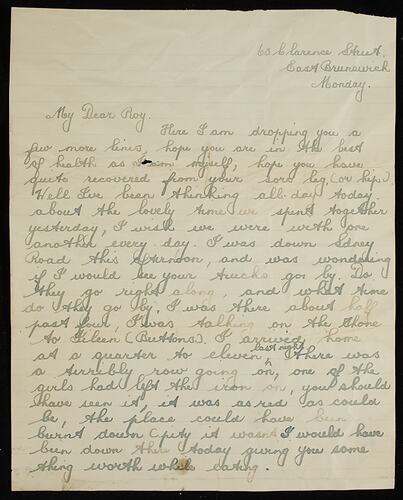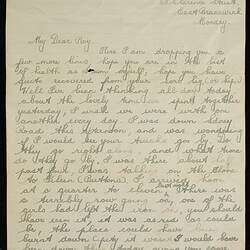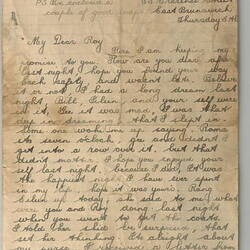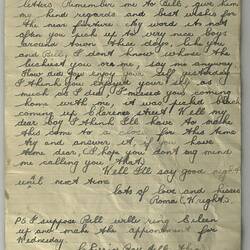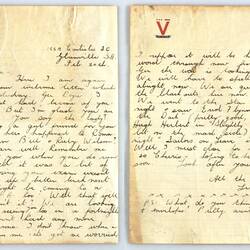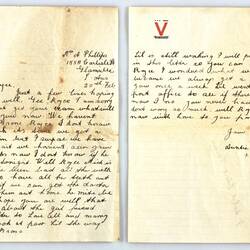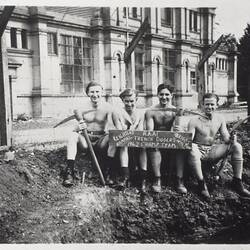Summary
Letter of two hand-written pages to 'Roy' on Monday. Undated; probably late 1941 to early 1942, as Royce only enlisted in the RAAF in December 1941.
Later page(s) missing. Although the author does not sign the letter, it is written in the hand of Roma Wright, who lives at 63 Clarence St, East Brunswick, who describes domestic activities and disasters, photos, etc. She mentions that they went out last night, and wants to know when his (military?) trucks will travel along Sydney Road so she can see them. She writes: 'Gosh I don't know how many things I've done wrong today (or supposed to have done). I upset a bucket of water all over the kitchen floor, broke the hose, spilt a kettle of boiling water, some one said its because I'm too much in love'. She mentions that one of 'the girls' had left an iron on' - suggesting she lives in shared accommodation. In April 1942 an advertisement was posted from 63 Clarence Street, East Brunswick, by W. Joyce, seeking a tailoress who was a 'first class coat hand'. The address was a private home.
The letter was found under the floorboards of the balcony level of the Gallery, Great Hall, Royal Exhibition Building, when replaced in 1989 as part of a restoration program. Many other items dating back to the 1940s were also found, providing an insight into the lifestyle and interests of RAAF personnel stationed in the building.
The letter was apparently written by Roma Wright, who sent Roy several other letters also found under the floorboards. The addressee may be Royce Phillips, who served as a Leading Aircraftman (AC1, or Aircraftman) in the Royal Australian Air Force during World War II, service number 47290. He enlisted on 9 December 1941 at Kilkenny, SA, and was discharged 5 Mar 1946. The suggestion of addressee is supported by a later letter clearly addressed to him that asks 'what has happened to Roma?' in response to a letter from Royce about a new girlfriend (SH 960274).
The formal wartime occupation of the Exhibition Building began in October 1940, when it was requisitioned for the RAAF under the National Security (General) Regulations. Partitioning work began in January 1941, and on 15 March the RAAF no.1 School of Technical Training was moved to the Exhibition Building from West Melbourne Technical School. Before long the Great Hall and surrounding areas were crowded with Air Force personnel. About 500 to 700 men lived there for varying periods of time; numbers peaked in 1942, when about 2000 personnel were accommodated. The central part of the building was a mess hall. The arena was occupied by a kitchen, laundry blocks, a storeroom and a playing field. The southern and eastern sides of the building were used for parades and drilling. The RAAF remained in control of the Exhibition Building until October 1946. (David Dunstan,1996, Victorian Icon)
Physical Description
Two-page hand-written letter in blue ink on white lined paper. The back of each page is blank. Letter is yellowed and faded. First page has stains; second page has insect damage.
Significance
This letter is significant as a rare and unintended survivor of a war-time romance in Melbourne. Its sender is identified as Roma Wright. A Roma Wright is named in the Argus on 25 July 1946, page 8 - one of a group of debutants, all hairdressers, at the cabaret ball of the Master Ladies Hairdressers' Association in the St Kilda Town Hall. On 30 June 1947, p.7, the Argus reports that Roma Wright of St Kilda has married Harold Anderson and has sailed to the United States - so presumably Harold was American. It is not known if this is the same Roma Wright who wrote the letter ST 960281.
More Information
-
Collection Names
-
Collecting Areas
-
Acquisition Information
Transfer from Trustees of the Royal Exhibition Building (REB), Sep 1991
-
Author
Roma C. Wright, Clarence Street, East Brunswick, Greater Melbourne, Victoria, Australia, 1941-1942
-
Addressed To
-
Inscriptions
Extensive hand-written text.
-
Classification
-
Category
-
Discipline
-
Type of item
-
Overall Dimensions
19.4 cm (Width), 24.2 cm (Height)
-
Dimensions
194 mm (Width), 243 mm (Height)
-
Dimensions
245 mm (Length), 194 mm (Width)
Measurement From Conservation. Measuring Method: Maximum dimensions of pages
-
References
1942 'Advertising', The Age (Melbourne, Vic. : 1854 - 1954), 27 April, p. 6. , viewed 20 May 2020, [Link 1]
[Book] Darian-Smith, Kate. 1990. On the home front: Melbourne in wartime 1939-1945.
[Book] Dunstan, David. 1996. Victorian Icon: The Royal Exhibition Building., 377-386 Pages
-
Keywords
Royal Exhibition Building, Wars & Conflicts, World War II, 1939-1945, Making History - War Diaries and Correspondence
